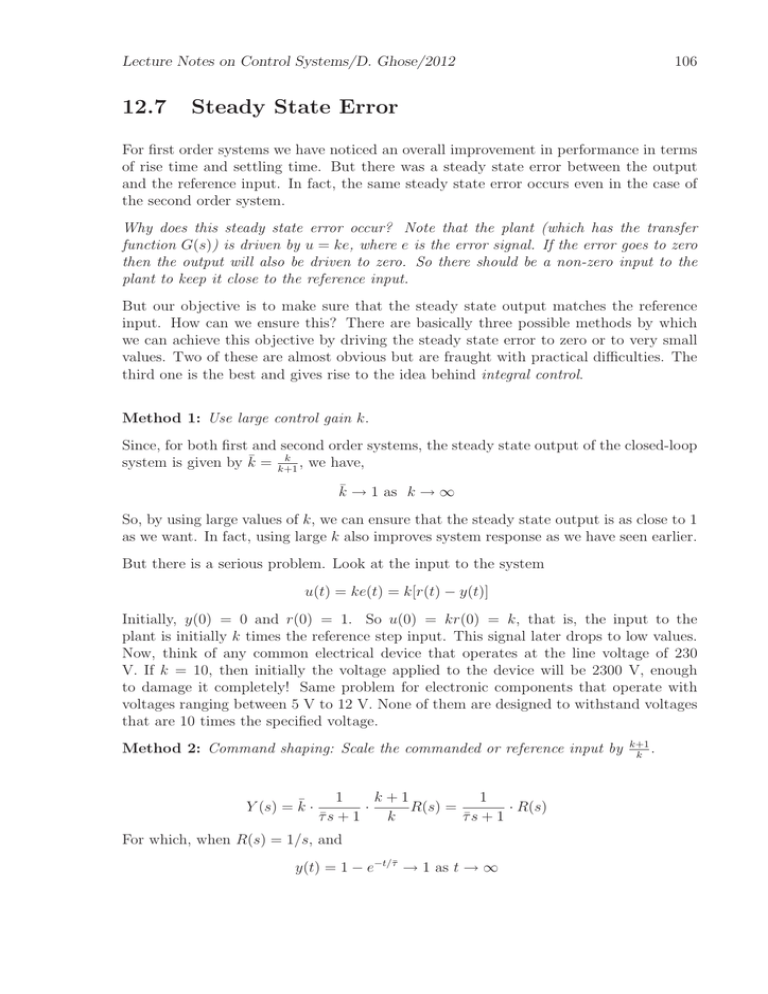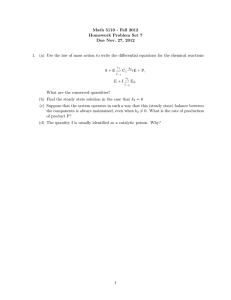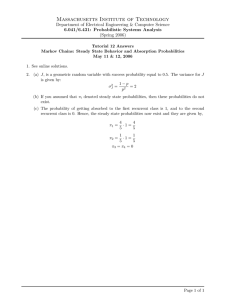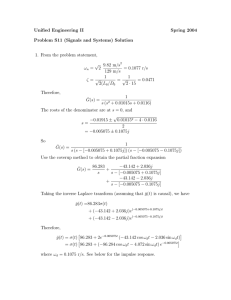12.7 Steady State Error
advertisement

Lecture Notes on Control Systems/D. Ghose/2012
12.7
106
Steady State Error
For first order systems we have noticed an overall improvement in performance in terms
of rise time and settling time. But there was a steady state error between the output
and the reference input. In fact, the same steady state error occurs even in the case of
the second order system.
Why does this steady state error occur? Note that the plant (which has the transfer
function G(s)) is driven by u = ke, where e is the error signal. If the error goes to zero
then the output will also be driven to zero. So there should be a non-zero input to the
plant to keep it close to the reference input.
But our objective is to make sure that the steady state output matches the reference
input. How can we ensure this? There are basically three possible methods by which
we can achieve this objective by driving the steady state error to zero or to very small
values. Two of these are almost obvious but are fraught with practical difficulties. The
third one is the best and gives rise to the idea behind integral control.
Method 1: Use large control gain k.
Since, for both first and second order systems, the steady state output of the closed-loop
k
system is given by k̄ = k+1
, we have,
k̄ → 1 as k → ∞
So, by using large values of k, we can ensure that the steady state output is as close to 1
as we want. In fact, using large k also improves system response as we have seen earlier.
But there is a serious problem. Look at the input to the system
u(t) = ke(t) = k[r(t) − y(t)]
Initially, y(0) = 0 and r(0) = 1. So u(0) = kr(0) = k, that is, the input to the
plant is initially k times the reference step input. This signal later drops to low values.
Now, think of any common electrical device that operates at the line voltage of 230
V. If k = 10, then initially the voltage applied to the device will be 2300 V, enough
to damage it completely! Same problem for electronic components that operate with
voltages ranging between 5 V to 12 V. None of them are designed to withstand voltages
that are 10 times the specified voltage.
Method 2: Command shaping: Scale the commanded or reference input by
Y (s) = k̄ ·
k+1
1
1
·
R(s) =
· R(s)
τ̄ s + 1
k
τ̄ s + 1
For which, when R(s) = 1/s, and
y(t) = 1 − e−t/τ̄ → 1 as t → ∞
k+1
.
k
Lecture Notes on Control Systems/D. Ghose/2012
107
Figure 12.9: Command shaping control
This appears to offer the solution we are looking for. However, this method will work
only when we know the open-loop gain exactly, which is unlikely since in a practical
system, gains are measured inaccurately and they may vary over operating ranges and
differing conditions.
Suppose, the actual open-loop gain is not k but is off by an amount δ. So, the open loop
gain is k = k + δ.
Then, the closed-loop gain is,
k+δ
k+δ+1
k+1
δ
k
·
=
+
k
k+δ+1 k+δ+1
(k + 1)δ
k+1
+
=
k + δ + 1 k(k + δ + 1)
δ
1
=
δ +
δ
1 + k+1
k 1 + k+1
=
∼
=
∼
=
=
k+1
k
δ
δ
δ
+ ··· + · 1 −
+ ···
1−
(Expanding in Taylor series)
k+1
k
k+1
δ
δ
δ
+ · 1−
(Ignoring 2nd order terms in δ)
1−
k+1 k
k+1
δ
δ
+
(Again ignoring 2nd order terms in δ)
1−
k+1 k
δ
1+
k(k + 1)
Thus, a non-zero steady state error still remains unless k is known exactly and does not
change during operation.
Method 3: Integral control.
For y = 0 in steady state, G(s) has to be driven by u = 0. But, if we kill the steady
state error completely
then this condition is no longer satisfied. So, instead of u = ke
let us try u = k e. Then e = r − y can go to zero while u = k e = 0.
Lecture Notes on Control Systems/D. Ghose/2012
108
Figure 12.10: Integral control
The corresponding block diagram is as shown below. The plots
alongside show that even
when e → 0, the area under the e curve which represents e is non-zero.
Consider a first-order system.
G(s) =
1
τs + 1
The open loop response is given by,
Yol (s) = G(s)R(s) =
1
R(s)
τs + 1
The closed loop response is given by,
k
· 1
G(s)K(s)
s τ s+1
Yc (s) =
=
1
1 + G(s)K(s)
1 + ks · τ s+1
=
k
k
τ
R(s)
=
R(s)
τ s2 + s + k
s2 + τs + τk
which is a second order system. Since,
2ζωn =
1
τ
is a constant, the settling time (∼
= 4/(ζωn )), is a constant too, irrespective of the value
of k.
What happens when you use the exact expression?
Steady state response to a step input is given by,
Yc (s) =
k
τ
s2 + τs
+
k
τ
·
1
s
Lecture Notes on Control Systems/D. Ghose/2012
109
The system is stable for all positive values of k. This can be shown by a simple application of the Routh-Hurwitz criterion.
s2 1
k
τ
s1
1
τ
0
s0
k
τ
0
The final value theorem can be applied to show that
yc (∞) = lim sYc (s) = 1
s→0
So there is no steady state error.
Finally, we can see that
ωn =
k
τ
1
ζ= √
2 kτ
which implies that the system is
Underdamped if ζ < 1 ⇐ k >
Overdamped if ζ > 1 ⇐ k <
1
4τ
1
4τ
So, for a first order system, integral control produces zero steady state error for step
inputs but runs the risk of oscillations in the output if the gain value k is large.
Let us consider a general second order system and examine how integral control affects
its performance.
Let the open loop system be given by,
Gol (s) =
ωn2
s2 + 2ζωn s + ωn2
Then, the closed loop system with integral control would be,
Gc (s) =
=
=
2
ωn
k
2 · s
s2 +2ζωn s+ωn
2
ωn
k
1 + s2 +2ζω
2 · s
n s+ωn
ωn2 k
s(s2 + 2ζωn s + ωn2 ) + ωn2 k
ωn2 k
s3 + 2ζωn s2 + ωn2 s + ωn2 k
Lecture Notes on Control Systems/D. Ghose/2012
110
This is a third order system which has 3 real poles or one real pole and a pair of complex
conjugate poles.
Let us check the stability of the system.
s3
1
ωn2
s2
2ζωn
ωn2 k
s1
2 −ω k
2ζωn
n
2ζ
0
s2
ωn2 k
0
From which we can see that the system will be stable if 0 < k < 2ζωn .
So, a second order system with integral control is stable only when this condition on k
is met.
Let us apply a step input and check the steady state response by applying the final value
theorem, assuming that the value of k is so chosen as to maintain stability. Then,
Y (s) =
ωn2 k
1
·
3
2
2
2
s + 2ζωn s + ωn s + ωn k s
So,
y(∞) = lim sY (s) = 1
s→0
which kills the steady state error.
12.8
Summary of Results
In this section we summarize the results obtained in the previous sections. We will
consider,
Class of systems: First order and Second order
Class of control: Proportional and Integral
Class of inputs: Step
Lecture Notes on Control Systems/D. Ghose/2012
111
Step input
P-Control K(s) = k
Integral Control K(s) =
Closed loop:
k
Gc (s) = k+1
· τ 1s+1
Closed loop:
Gc (s) = s2 +(1/τk/τ
)s+(k/τ )
k
s
First Order System
Open loop:
1
G(s) = τ s+1
k+1
(Second order system)
k
k+1
Gain = 1
Gain =
Time constant = τ
Time constant =
Tr ∼
= 2.2τ
Tr ∼
=
2.2τ
k+1
Ts ∼
= 3.9τ
Ts ∼
=
3.9τ
k+1
Gain = 1
τ
k+1
Tr ∼
=
π
2ωn
Ts ∼
=
Steady state error = 0 Steady state error =
1
k+1
=
4
ζωn
π
2
τ
k
= 8τ
Steady state error = 0
Second Order System
Open loop:
2
ωn
G(s) = s2 +2ζω
2
n s+ω
n
Closed loop:
2
nk
Gc (s) = s2 +2ζωnωs+ω
2 (k+1)
=
y(∞) = 1
Stable
k
k+1
·
n
2 (k+1)
ωn
2 (k+1)
s2 +2ζωn s+ωn
y(∞) =
k
k+1
Stable
Closed loop:
2k
Gc (s) = s3 +2ζωn sω2n+ω
2 s+ω 2 k
n
n
y(∞) = 1
k < 2ζωn (stable)
k ≥ 2ζωn (unstable)
Problem Set 6
1. Let G(s) = sτ1+1 be a first order system. Assume some value for τ and plot the
open loop response to a step and a ramp input.
2. For the same system consider a feedback with just P-control. For three different
values of gain K plot the time response for a unit step and a unit ramp input.
3. Now consider a integral control. Select two values of K, one making the system
Lecture Notes on Control Systems/D. Ghose/2012
112
underdamped and the other overdamped and plot the time responses to step and
ramp inputs.
2
ωn
4. Consider a second order system G(s) = s2 +2ζω
2 and assume reasonable values
n s+ωn
for ζ and ωn . Do the same as above. Only in PI-control, select K such that one
system is stable and the other unstable.
5. Compare the rise time, settling time, steady state error, etc. of the above time
responses and comment on them.
Note: Use MATLAB. Select parameter values that are different from other students’ !
12.9
Disturbance Signals
One of the properties of a feedback system is that of disturbance rejection. Disturbance
signals can appear at the system input, the system output, or at the sensor.
Figure 12.11: A feedback system with many input signals
In order to find the effect of these disturbance signals we need to find the closed-loop
transfer functions from each noise term to the output Y . In the following, we will drop
the argument s (the laplace variable) from the equations for clarity.
Y
=
=
=
=
Do + Y Do + G(U + Di )
Do + G(KE + Di )
Do + G[K(R − R ) + Di ]
Lecture Notes on Control Systems/D. Ghose/2012
113
= Do + G[K{R − H(Y + N )} + Di ]
= Do + G[KR − KHY − KHN + Di ]
= Do + GKR − GKHY − GKHN + GDi
So,
Y
KGH
G
1
KG
Do +
R−
N+
Di
1 + KGH
1 + KGH
1 + KGH
1 + KGH
= G Do D o + G R R + G N N + G D i D i
=
where,
1
1 + KGH
KG
=
1 + KGH
KGH
=
1 + KGH
G
=
1 + KGH
GDo =
GR
GN
GDi
are the closed-loop transfer functions from the corresponding disturbance inputs to the
output, when all other inputs are considered to be zero.
So, a design objective would be to select K(s) and H(s) so that
KG
R should have a ”good” response
1 + KGH
YDo , YN , YDi should all be small
YR =
However, there has to be a trade-off since these four transfer functions are not independent and there are only two parameters K(s) and H(s). For example, note that,
GDo + GN =
1
KGH
+
=1
1 + KGH 1 + KGH
So, if the effect of the sensor noise N on the output is small, then the effect of the output
disturbance Do has to be large, provided that the level of both disturbance signals are
the same.




